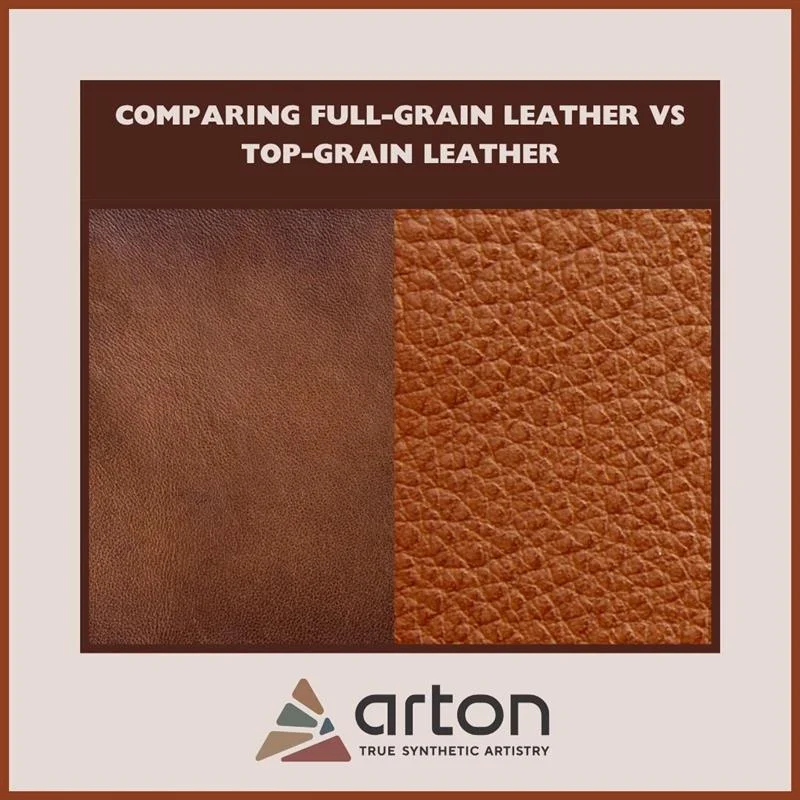03 July, 2025
Whether it's a comfortable pair of shoes, or a classy piece of furniture, the type of leather material employed mostly determines how it will look, feel, hold its own and even the price. Nevertheless, most consumers lack the important knowledge about the two most conspicuous types of leather in the market, namely Full-Grain Leather and Top-Grain Leather.
Such disparities not only influence the aesthetic but also play into such factors as durability, maintenance needs, and user satisfaction levels as well. In this guide, you will be able to learn everything about these two types of grain leather and then make a good and sound purchase that will deliver you the best value for your money.
What is Full-Grain Leather?

Definition and Characteristics
Full grain leather is considered to be the best and the most top-notch type of leather. It is derived from the very top layer of the hide, which contains the most tightly packed fibers that make the leather incredibly durable and tough. What distinguishes full grain leather material is that it remains untouched, unpolished, and uncorrected, meaning it retains the natural grain, along with any marks or blemishes from the animal's life, such as scars, stretch marks, insect bites, and wrinkles.
These imperfections are not viewed as flaws but as features that give each product its own unique identity and natural charm, something that mass-produced synthetic or corrected leather can never offer.
Benefits of Full-Grain Leather
-
Superior Strength & Longevity: Since full-grain leather preserves the hide’s complete grain structure, it is uncommonly strong and durable. Well-cared-for full-grain leather items can endure for decades, sometimes even being handed down as cherished heirlooms.
-
Beautiful Patina Formation: Over time, full-grain leather ages gracefully, developing a patina a lustrous, deeper hue that accentuates the material’s natural beauty.
-
Natural Breathability: The surface is left unmodified, enabling the circulation of air and moisture in such a way that any material used on the surface, such as the upholstery of the furniture or shoes, will get comfortable contact with the surface, thus limiting the accumulation of sweat or bad smell.
-
Rich and Authentic Appearance: Every scratch or scar on the leather tells a story, giving each piece a one-of-a-kind look. For example, a black full grain leather bag may reveal a unique patina over years of use, unlike any other.
Drawbacks of Full-Grain Leather
-
Higher Price: Full-grain leather’s superior qualities come at a cost. It is generally the most expensive leather on the market.
-
Weight and Stiffness: Due to its thickness and density, full-grain leather products may feel heavier and stiffer initially, requiring some breaking-in.
-
Visible Natural Marks: While some appreciate the raw look, others who prefer a flawless, uniform finish might find the natural blemishes undesirable.
What is Top-Grain Leather?
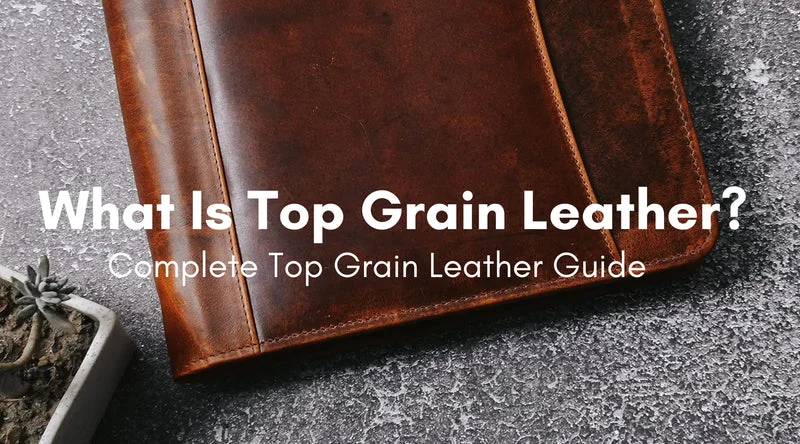
Definition and Characteristics
Top-grain leather enjoys widespread appeal, though it sits below full-grain in regard to quality. Although it still comes from the outermost layer of the hide, the surface is sanded and buffed to remove defects such as scars and insect marks. Once the leather has been sanded smooth, it is frequently coated or embossed to produce a uniform finish.
Consequently, top grain leather is frequently chosen for items that call for a smooth and unblemished finish, including modern furniture, luxury handbags, and car seats.
Benefits of Top-Grain Leather
-
Smooth and Polished Look: Through this sanding step, a flawlessly smooth, glossy surface is achieved, thereby classifying top-grain leather as perfect for items that require the highest visual standards.
-
Flexibility and Softness: Owing to its softness and greater flexibility, top-grain leather adapts readily to a wide array of shapes and styles for example, fashion bags and jackets.
-
Resistance to Staining and Spills: After the protective finishes are applied following sanding, top-grain leather becomes more resilient to water, stains, and dirt, making care and maintenance simpler.
-
More Affordable Option: After the protective finishes are applied following sanding, top-grain leather becomes more resilient to water, stains, and dirt, making care and maintenance simpler.
Drawbacks of Top-Grain Leather
-
Lower Durability: The sanding process weakens the leather’s natural fiber structure and, over the long term, leaves top-grain leather less durable than full-grain.
-
No Patina Development: In contrast with full-grain, top-grain leather does not acquire a patina over time. Rather, its outward look typically stays unchanged over the years, a trait that some leather enthusiasts regard as artificial.
-
Less Breathable: The surface coating used for top-grain leather reduces its breathability, which might lead to discomfort in certain applications like shoes or gloves.
How to Identify Full-Grain Leather vs Top-Grain Leather
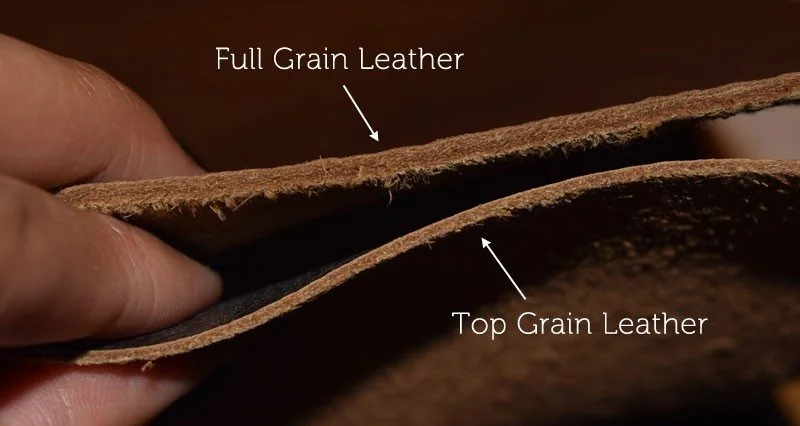
-
Surface Appearance – Full-grain leather will exhibit a raw and natural texture filled with visible scars, pores, and wrinkles, each telling a unique story. Conversely, top-grain leather receives its uniform, perfectly smooth surface through mechanical sanding and polishing.
-
Touch and Flexibility – When touched, full-grain leather comes across as thicker, harder, and more resilient, whereas top-grain feels softer, thinner, and more supple, which makes it easier to mold and shape into intricate designs.
-
Edge Treatment – The edges of full-grain leather products often appear natural, fibrous, and unsealed, emphasizing their organic origin. Conversely, top-grain leather goods are ordinarily finished by sealing or coating the edges, resulting in a more polished, large-scale look.
-
Water Absorption – In a simple water drop test, full-grain leather will absorb the droplet quickly, darkening temporarily as the moisture penetrates. Armed with surface treatments, top-grain leather generally causes water to gather into beads that swiftly roll away without penetrating.
-
Smell – Full-grain leather exudes a deep, rich, and unmistakable scent of natural leather, whereas top-grain leather may have a fainter or slightly synthetic aroma due to the chemicals used in finishing processes.
-
Price Factor – Because of its premium status, full-grain leather commands a correspondingly higher price due to its superior quality and extended lifespan. Owing to its more affordable price, top-grain leather captivates budget-conscious shoppers searching for premium quality.
Full-Grain Leather vs. Top-Grain Leather: A Side-by-Side Comparison
| Feature | Full-Grain Leather | Top-Grain Leather |
| Origin | Outermost hide layer, completely natural | Outermost layer, surface corrected and sanded |
| Appearance | Unique, natural grain with visible marks | Smooth, consistent, flawless finish |
| Durability | Extremely high, lasts decades | Moderate, may show wear after a few years |
| Aging (Patina) | Develops a rich, distinctive patina over time | Retains original finish, no patina formation |
| Maintenance | Requires conditioning and care | Easier to clean, stain-resistant |
| Price | Highest | Moderate |
| Comfort | Breathable and sturdy | Soft, flexible, less breathable |
| Common Uses | Luxury bags, boots, belts, and premium furniture | Fashion items, office furniture, jackets |
How Each Leather Type is Used in Different Industries
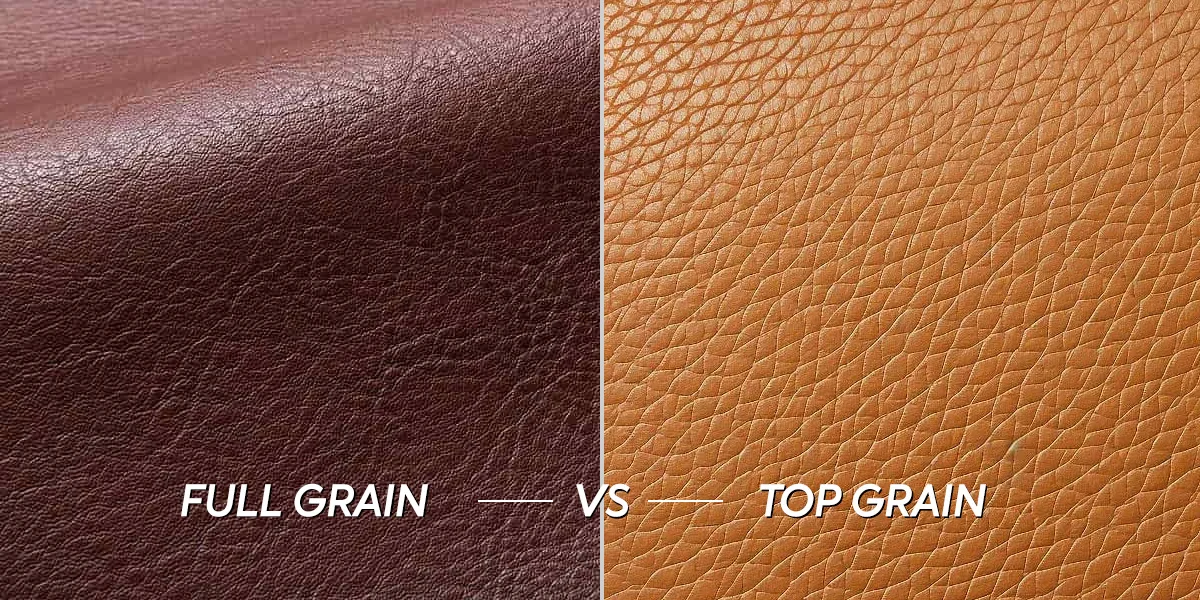
Fashion and Accessories
-
Full-Grain Leather: It is very popular among luxury brands in luxury handbags, wallets, belts, and customized shoes. Limited edition or designer will have that exclusivity and charm in its aging quality of the leather.
-
Top-Grain Leather: Applied to fashion products that have to have a smooth touch, and are sold daily, jackets, purses, and clutches, where the cost factor and homogeneity of the look matter.
Furniture Industry
-
Full-Grain Leather: Known to make statement furnishing like vintage chairs, high-quality office chairs, and luxury sofas. Its thick texture ensures an unsurpassed durability in the case of frequent use.
-
Top-Grain Leather: The suitable design in modern minimalistic furniture pieces is where a uniform color and texture are maintained, such as corporate sofas, restaurant seats and hotel furniture.
Footwear Industry
-
Full-Grain Leather: Applied in heavy-duty footwear such as hiking boots, work shoes, and formal dressing shoes that necessitate rare endurance.
-
Top-Grain Leather: Available in sports shoes and fashion sneakers that need softness and flexibility of the shoe to be able to comfortably wear them.
Automotive Industry
-
Full-Grain Leather: Applied in high-end luxury vehicles and classic cars to give interiors a rich, aged look over time.
-
Top-Grain Leather: Used widely in mass-market car interiors due to its affordable cost and easy cleaning properties
Leather Care Tips for Long-Lasting Beauty
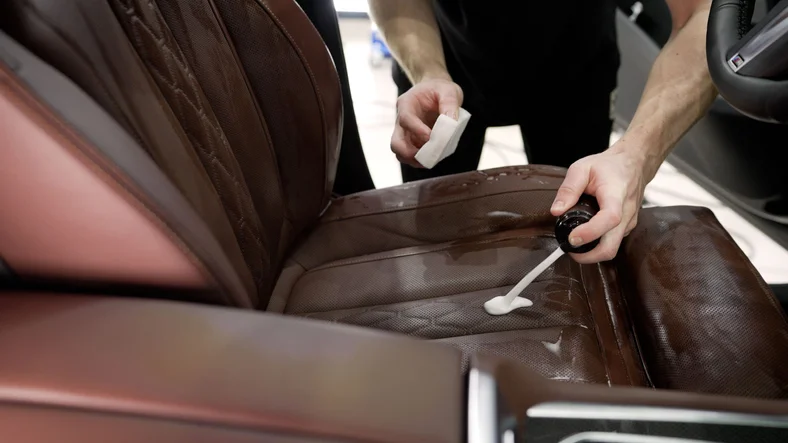
For Full-Grain Leather:
-
Regularly apply high-quality leatherette conditioner to prevent dryness and cracking.
-
Protect from prolonged exposure to sunlight and water to maintain its finish.
-
Use a leather balm to enhance the development of the natural patina.
For Top-Grain Leather:
-
Wipe with a damp cloth and mild soap to remove dirt and spills.
-
Occasionally treat with a leather protector to maintain the smooth finish.
-
Avoid sharp objects that may scratch the surface coating.
Get Best Quality Artificial Leather
Why Sourcing from Trusted Suppliers Matters
In case of buying artificial leather products or raw materials in large quantities, it is better to have a partnership with well-known leather suppliers so that they provide you with original leather that is of the grade or specification that is announced. Companies such as Rock Uniquoters establish a benchmark in the supply of industrial raw materials since they have been able to sustain supplying quality commodities and gaining customer confidence. Similarly, it is equally important that the supply of polyvinyl chloride leather is sound so that the leather you purchase, be it full-grain or top-grain, is of high quality and is real and ethical.
In addition to traditional hides, Rock Uniquoters is also a major supplier of faux PVC leather, offering versatile solutions for interiors, fashion, and automotive use. Their range includes PVC leather material options for modern upholstery, alternatives for budget-friendly designs, and high-performance that mimics the luxury of natural leather. They also supply
Conclusion
Choosing between full-grain and top-grain leather ultimately depends on your specific needs, budget, and usage preferences.
Opt for Full-Grain Leather if you value:
-
Long-term durability and strength.
-
Natural, unique appearance.
-
An evolving patina that tells a story over time.
Select Top-Grain Leather if you prioritize:
-
A sleek, uniform look for fashion or furniture.
-
Easier cleaning and maintenance.
-
Affordable luxury with sufficient durability.
By understanding these critical differences, you can ensure your next leather purchase meets your expectations whether it’s for personal style, industrial sourcing, or interior design.

